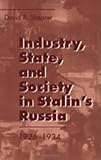Industry, State, and Society in Stalin's Russia, 1926–1934 / David R. Shearer.
Material type: TextPublisher: Ithaca, NY : Cornell University Press, [2018]Copyright date: ©1997Description: 1 online resource (288 p.) : 9 halftones, 2 chartsContent type:
TextPublisher: Ithaca, NY : Cornell University Press, [2018]Copyright date: ©1997Description: 1 online resource (288 p.) : 9 halftones, 2 chartsContent type: - 9781501729867
- 338.947/009/042 20
- online - DeGruyter
| Item type | Current library | Call number | URL | Status | Notes | Barcode | |
|---|---|---|---|---|---|---|---|
 eBook
eBook
|
Biblioteca "Angelicum" Pont. Univ. S.Tommaso d'Aquino Nuvola online | online - DeGruyter (Browse shelf(Opens below)) | Online access | Not for loan (Accesso limitato) | Accesso per gli utenti autorizzati / Access for authorized users | (dgr)9781501729867 |
Frontmatter -- Contents -- Acknowledgments -- Abbreviations -- Introduction: Stalinism and the Industrial State -- I. THE STATE(S) OF THE ECONOMY IN THE LATE 1920s -- 1. Unruly Bureaucracies, Fragmented Markets -- 2. Wheeling and Dealing in Soviet Industry -- 3. Rabkrin and the Militarized Campaign Economy -- II. THE STRUGGLE FOR A NEW STATE, 1928-1930 -- 4. What Kind of State? -- 5. The Politics of Modernization -- III. WORKING IN THE MADHOUSE, 1930-1934 -- 6. Daily Work in the Apparat -- 7. Purge and Patronage -- 8. The Pathologies of Modernization -- Conclusion: Socialism, Dictatorship, and Despotism in Stalin's Russia -- Glossary -- Bibliography -- Index
restricted access online access with authorization star
http://purl.org/coar/access_right/c_16ec
In his reexamination of the origins of the Stalinist state during the formative period of rapid industrialization in the late 1920s and early 1930s, David R. Shearer argues that a centralized state-controlled economic system was the consciously conceived political creation of Stalinist leaders rather than the inevitable by-product of socialist industrialization.Focusing on the different economic and bureaucratic cultures within the industrial system, Shearer reconstructs the debates in 1928 and 1929 over administrative, financial, and commercial reform. He uses information from recently opened archives to show that attempts by the state's trading organizations to create a commercial economy enjoyed wide support, offering a model that combined planning and rapid industrialization with social democracy and economic prosperity. In an effort to crush the syndicate movement and establish tight political control over the economy, Stalinist leaders intervened with a program of radical reforms. Shearer demonstrates that professional engineers, planners and industrial administrators in many cases actively supported the creation of a powerful industrial state unhampered by domestic social and economic constraints.The paradoxical result, Shearer shows, was a loss of control. The overly centralized system that emerged during the first Five-Year Plan was rendered incoherent by periodic economic crises and the continuing influence of partially suppressed social and market forces.
Mode of access: Internet via World Wide Web.
In English.
Description based on online resource; title from PDF title page (publisher's Web site, viewed 26. Apr 2024)


